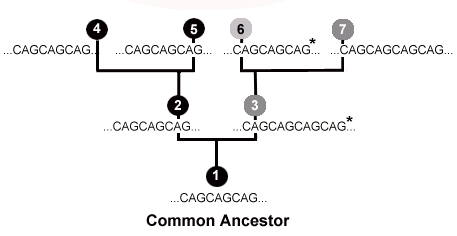Microsatellites are short stretches of DNA that contain many repeats of 2-5 nucleotide segments. During DNA replication the polymerase either adds repeat segments or skips repeat segments because it loses its place. Microsatellites are found on autosomal and sex chromosomes. In the case of autosomal microsatellites there is a rapid rate of mutation that can be determined by laboratory observation which thus provides a more reliable coalescence time. The current value for the coalescence time is 156,000YA.
Figure 17 depicts the process of microsatellite mutation. The problem of using microsatellites as indicators of common ancestory is due to homoplasy. Homoplasy is when alleles are characteristically identical but evolutionarily different (due to converging mutations).
Another issue with using microsatellites for this purpose is that they are in the nuclear genome and distributed across 23 chromosomes (cannot be treated independently).

Figure 17: Microsatellite mutation. As indicated, population 3 mutates, obtaining an additional CAG segment. When it produces populations 6 and 7, 6 has mutated to correct 3's mutation. Therefore 6 would appear to have common ancestory with populations 4 and 5.